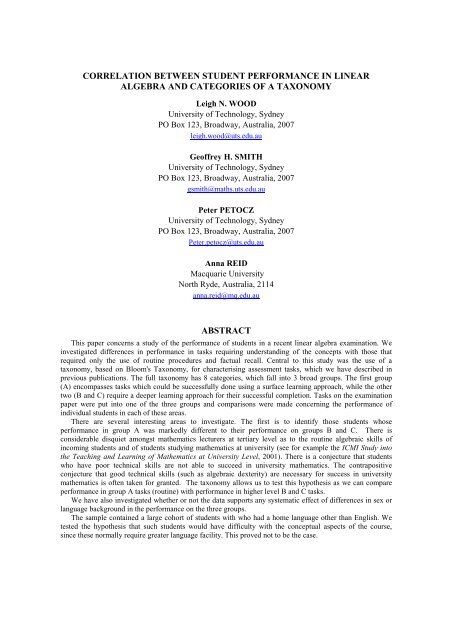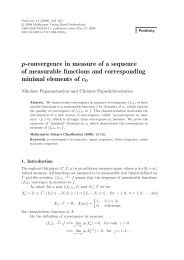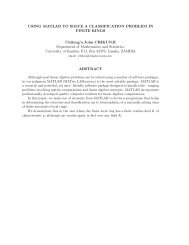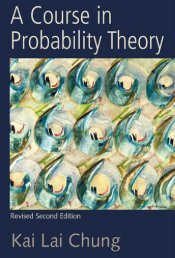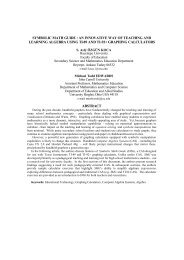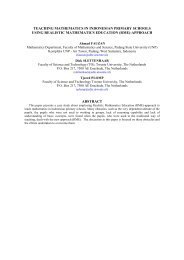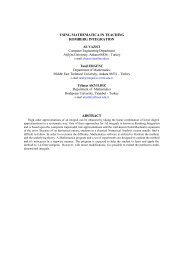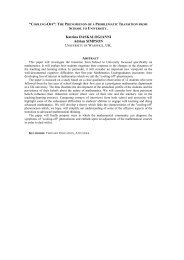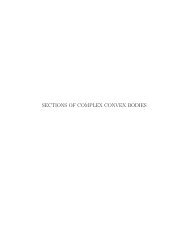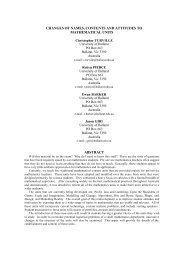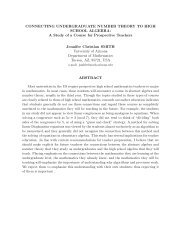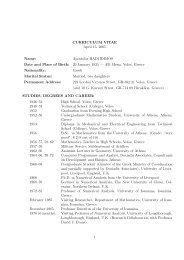correlation between student performance in linear algebra and ...
correlation between student performance in linear algebra and ...
correlation between student performance in linear algebra and ...
You also want an ePaper? Increase the reach of your titles
YUMPU automatically turns print PDFs into web optimized ePapers that Google loves.
CORRELATION BETWEEN STUDENT PERFORMANCE IN LINEAR<br />
ALGEBRA AND CATEGORIES OF A TAXONOMY<br />
Leigh N. WOOD<br />
University of Technology, Sydney<br />
PO Box 123, Broadway, Australia, 2007<br />
leigh.wood@uts.edu.au<br />
Geoffrey H. SMITH<br />
University of Technology, Sydney<br />
PO Box 123, Broadway, Australia, 2007<br />
gsmith@maths.uts.edu.au<br />
Peter PETOCZ<br />
University of Technology, Sydney<br />
PO Box 123, Broadway, Australia, 2007<br />
Peter.petocz@uts.edu.au<br />
Anna REID<br />
Macquarie University<br />
North Ryde, Australia, 2114<br />
anna.reid@mq.edu.au<br />
ABSTRACT<br />
This paper concerns a study of the <strong>performance</strong> of <strong>student</strong>s <strong>in</strong> a recent l<strong>in</strong>ear <strong>algebra</strong> exam<strong>in</strong>ation. We<br />
<strong>in</strong>vestigated differences <strong>in</strong> <strong>performance</strong> <strong>in</strong> tasks requir<strong>in</strong>g underst<strong>and</strong><strong>in</strong>g of the concepts with those that<br />
required only the use of rout<strong>in</strong>e procedures <strong>and</strong> factual recall. Central to this study was the use of a<br />
taxonomy, based on Bloom's Taxonomy, for characteris<strong>in</strong>g assessment tasks, which we have described <strong>in</strong><br />
previous publications. The full taxonomy has 8 categories, which fall <strong>in</strong>to 3 broad groups. The first group<br />
(A) encompasses tasks which could be successfully done us<strong>in</strong>g a surface learn<strong>in</strong>g approach, while the other<br />
two (B <strong>and</strong> C) require a deeper learn<strong>in</strong>g approach for their successful completion. Tasks on the exam<strong>in</strong>ation<br />
paper were put <strong>in</strong>to one of the three groups <strong>and</strong> comparisons were made concern<strong>in</strong>g the <strong>performance</strong> of<br />
<strong>in</strong>dividual <strong>student</strong>s <strong>in</strong> each of these areas.<br />
There are several <strong>in</strong>terest<strong>in</strong>g areas to <strong>in</strong>vestigate. The first is to identify those <strong>student</strong>s whose<br />
<strong>performance</strong> <strong>in</strong> group A was markedly different to their <strong>performance</strong> on groups B <strong>and</strong> C. There is<br />
considerable disquiet amongst mathematics lecturers at tertiary level as to the rout<strong>in</strong>e <strong>algebra</strong>ic skills of<br />
<strong>in</strong>com<strong>in</strong>g <strong>student</strong>s <strong>and</strong> of <strong>student</strong>s study<strong>in</strong>g mathematics at university (see for example the ICMI Study <strong>in</strong>to<br />
the Teach<strong>in</strong>g <strong>and</strong> Learn<strong>in</strong>g of Mathematics at University Level, 2001). There is a conjecture that <strong>student</strong>s<br />
who have poor technical skills are not able to succeed <strong>in</strong> university mathematics. The contrapositive<br />
conjecture that good technical skills (such as <strong>algebra</strong>ic dexterity) are necessary for success <strong>in</strong> university<br />
mathematics is often taken for granted. The taxonomy allows us to test this hypothesis as we can compare<br />
<strong>performance</strong> <strong>in</strong> group A tasks (rout<strong>in</strong>e) with <strong>performance</strong> <strong>in</strong> higher level B <strong>and</strong> C tasks.<br />
We have also <strong>in</strong>vestigated whether or not the data supports any systematic effect of differences <strong>in</strong> sex or<br />
language background <strong>in</strong> the <strong>performance</strong> on the three groups.<br />
The sample conta<strong>in</strong>ed a large cohort of <strong>student</strong>s with who had a home language other than English. We<br />
tested the hypothesis that such <strong>student</strong>s would have difficulty with the conceptual aspects of the course,<br />
s<strong>in</strong>ce these normally require greater language facility. This proved not to be the case.
1. Introduction<br />
This paper <strong>in</strong>vestigates <strong>student</strong>s’ <strong>performance</strong> on an exam<strong>in</strong>ation—<strong>and</strong> by extension their<br />
learn<strong>in</strong>g <strong>in</strong> the subject—from the po<strong>in</strong>t of view of a taxonomy of mathematical tasks. It exam<strong>in</strong>es<br />
various hypotheses about factors that may affect the nature <strong>and</strong> success of <strong>student</strong>s learn<strong>in</strong>g.<br />
Assessment is a central feature of teach<strong>in</strong>g <strong>in</strong> formal <strong>in</strong>stitutions <strong>and</strong> can take a multitude of<br />
forms, fulfill<strong>in</strong>g many functions, both <strong>in</strong>tended <strong>and</strong> un<strong>in</strong>tended. Ideally assessment should be<br />
l<strong>in</strong>ked closely with <strong>student</strong> learn<strong>in</strong>g. We look at a taxonomy for learn<strong>in</strong>g <strong>in</strong> mathematics (Smith et<br />
al 1996) that is related to that of Bloom (1956). It transforms the notion that learn<strong>in</strong>g is related to<br />
what we as educators do to <strong>student</strong>s, to how <strong>student</strong>s underst<strong>and</strong> a specific learn<strong>in</strong>g doma<strong>in</strong>, how<br />
they perceive their learn<strong>in</strong>g situation <strong>and</strong> how they respond to this perception with<strong>in</strong> exam<br />
conditions.<br />
We will particularly look at exam<strong>in</strong>ations because we believe that a major component of the<br />
f<strong>in</strong>al grade will cont<strong>in</strong>ue to be contributed by exam<strong>in</strong>ation of <strong>in</strong>dividual <strong>student</strong>s. As Krantz<br />
(1999:57) says ‘The pr<strong>in</strong>ciple device for determ<strong>in</strong><strong>in</strong>g grades is the exam<strong>in</strong>ation’. There are many<br />
reasons for this. Firstly, it is a practical, cost-effective way to assess large numbers of <strong>student</strong>s.<br />
Secondly, exam<strong>in</strong>ations are seen by many as objective with no favouritism <strong>and</strong> provid<strong>in</strong>g equity,<br />
as all <strong>student</strong>s are treated under the same conditions. Thirdly, exam<strong>in</strong>ations provide quality<br />
assurance <strong>and</strong> accountability, especially for adm<strong>in</strong>istrators. Fourthly, exam<strong>in</strong>ations have a long<br />
historical precedent <strong>in</strong> mathematics <strong>and</strong> <strong>in</strong> educational areas where certification is <strong>in</strong>volved. All of<br />
these reasons for ma<strong>in</strong>ta<strong>in</strong><strong>in</strong>g exams focus on their format <strong>and</strong> adm<strong>in</strong>istration.<br />
Whether we focus on exam<strong>in</strong>ations or other forms of assessment, we can use a range of<br />
techniques to assess the nature <strong>and</strong> extent of <strong>student</strong> learn<strong>in</strong>g. Our decisions about just which<br />
forms of assessment we choose are likely to be affected by the particular learn<strong>in</strong>g context <strong>and</strong> by<br />
the type of learn<strong>in</strong>g outcome we wish to achieve. Essentially, good assessment processes:<br />
• Encourage mean<strong>in</strong>gful learn<strong>in</strong>g when tasks encourage underst<strong>and</strong><strong>in</strong>g,<br />
<strong>in</strong>tegration <strong>and</strong> application.<br />
• Are valid when tasks <strong>and</strong> criteria are clearly related to the learn<strong>in</strong>g objectives <strong>and</strong><br />
when marks or grades genu<strong>in</strong>ely reflect <strong>student</strong>s’ levels of achievement.<br />
• Are reliable when markers have a shared underst<strong>and</strong><strong>in</strong>g of what the criteria are<br />
<strong>and</strong> what they mean.<br />
• Are fair if <strong>student</strong>s know when <strong>and</strong> how they are go<strong>in</strong>g to be assessed, what is<br />
important <strong>and</strong> what st<strong>and</strong>ards are expected.<br />
• Are equitable when they ensure that <strong>student</strong>s are assessed on their learn<strong>in</strong>g <strong>in</strong><br />
relation to the objectives.<br />
• Inform teachers about their <strong>student</strong>s’ learn<strong>in</strong>g (see Brown et al, 1997,<br />
Brockbank & McGill, 1998 or Biggs, 1999 for greater discussion on the relations <strong>between</strong><br />
assessment <strong>and</strong> learn<strong>in</strong>g).<br />
With regard to the importance of assessment, Ramsden (1992) says that ‘From our <strong>student</strong>s’<br />
po<strong>in</strong>t of view, assessment always def<strong>in</strong>es the actual curriculum. In the last analysis, that is where<br />
the curriculum resides for them, not <strong>in</strong> the lists of topics or objectives. Assessment sends messages<br />
about the st<strong>and</strong>ard <strong>and</strong> amount of work required, <strong>and</strong> what aspects of the syllabus are most<br />
important. Too much assessed work leads to superficial approaches; clear <strong>in</strong>dications of<br />
priorities <strong>in</strong> what has to be learned, <strong>and</strong> why it has to be learned, provide fertile ground for deep<br />
approaches’ (p187).
It follows that <strong>student</strong>s will look carefully at the range of assessment tasks—<strong>in</strong>clud<strong>in</strong>g<br />
exam<strong>in</strong>ations—that are <strong>in</strong>volved <strong>in</strong> any course of study. In mathematics courses, <strong>student</strong>s usually<br />
have access to previous exam<strong>in</strong>ation papers <strong>and</strong> these very papers give a clear <strong>in</strong>dication of the<br />
nature <strong>and</strong> extent of their course, <strong>and</strong> the sorts of th<strong>in</strong>gs that they need to concentrate on <strong>in</strong> order to<br />
achieve high marks or grades <strong>in</strong> their courses.<br />
2. Exam<strong>in</strong>ations<br />
The nature of exam<strong>in</strong>ations themselves will change <strong>in</strong> both content <strong>and</strong> format. Onl<strong>in</strong>e delivery<br />
with <strong>in</strong>dividualised questions will supplement paper-based <strong>and</strong> oral exam<strong>in</strong>ations provid<strong>in</strong>g a<br />
range of flexibility. The content will change with access to technology, which makes many rout<strong>in</strong>e<br />
skills less important. Employers are look<strong>in</strong>g for cognitive <strong>and</strong> communication skills <strong>in</strong> graduates<br />
<strong>and</strong> this will be reflected <strong>in</strong> the questions asked <strong>in</strong> exam<strong>in</strong>ations. Students will be able to use a<br />
variety of tools <strong>in</strong> the exam<strong>in</strong>ation, open-book <strong>and</strong>/or computer if appropriate. These changes take<br />
place <strong>in</strong> the context of chang<strong>in</strong>g classroom environments where higher order conceptions of<br />
learn<strong>in</strong>g are encouraged through the use of support<strong>in</strong>g <strong>student</strong> focused activities (Reid & Petocz,<br />
2001). Assessment is a tool that can be used by <strong>student</strong>s to develop the depth of their<br />
underst<strong>and</strong><strong>in</strong>g of a topic, <strong>and</strong> also to demonstrate this depth to their teachers. Exam<strong>in</strong>ations have<br />
the same potential but often send a contrary message. This contrary message is generated by the<br />
weight<strong>in</strong>g given to certa<strong>in</strong> questions <strong>and</strong> thus to the relative importance given to them by <strong>student</strong>s.<br />
Hence academics sett<strong>in</strong>g exam<strong>in</strong>ations need to consider the exam<strong>in</strong>ation as part of the <strong>student</strong>s’<br />
overall learn<strong>in</strong>g experience <strong>and</strong> accord<strong>in</strong>gly need to focus the exam on issues <strong>and</strong> contexts that<br />
encourage a cont<strong>in</strong>uation of higher order conceptual th<strong>in</strong>k<strong>in</strong>g. It is important to remember that one<br />
quality of higher order conceptions of learn<strong>in</strong>g is that they are <strong>in</strong>clusive <strong>and</strong> <strong>in</strong>tegrated. This means<br />
that by encourag<strong>in</strong>g higher order conceptions through class activities <strong>and</strong> assessments, we are also<br />
encourag<strong>in</strong>g the use of rout<strong>in</strong>e activities with<strong>in</strong> that context. Crawford et al (1994) show this<br />
clearly <strong>in</strong> their categories that describe <strong>student</strong> learn<strong>in</strong>g of mathematics. In their work on<br />
<strong>in</strong>novative exam<strong>in</strong>ation questions, Smith et al (1996) <strong>and</strong> Ball et al (1998) show how the nature of<br />
the exam<strong>in</strong>ation questions directs <strong>student</strong>s toward demonstrat<strong>in</strong>g either their underst<strong>and</strong><strong>in</strong>g of<br />
ideas or simply their ability to perform rout<strong>in</strong>e functions.<br />
Our categories of mathematics learn<strong>in</strong>g, developed from Blooms’ taxonomy, provide a schema<br />
through which we can evaluate the nature of exam<strong>in</strong>ation questions <strong>in</strong> mathematics to ensure that<br />
there is a mix of questions that will enable <strong>student</strong>s to show the quality of their learn<strong>in</strong>g at several<br />
levels.<br />
3. Use of a taxonomy<br />
We have been us<strong>in</strong>g a taxonomy (Table 1) to ensure that exam<strong>in</strong>ations conta<strong>in</strong> a mix of<br />
questions to test skills <strong>and</strong> concepts. The taxonomy was developed due to our desire to encourage<br />
a deep approach to learn<strong>in</strong>g. Previous studies have shown that many <strong>student</strong>s arrive at university<br />
with a surface approach to learn<strong>in</strong>g mathematics (Crawford et al, 1996) <strong>and</strong> that this affects their<br />
results at university. There are many ways to encourage a shift to deep learn<strong>in</strong>g, <strong>in</strong>clud<strong>in</strong>g<br />
assessment, learn<strong>in</strong>g experiences, teach<strong>in</strong>g methods, <strong>and</strong> attitud<strong>in</strong>al changes. The taxonomy<br />
addresses the issue of assessment. It can be applied to all assessment tasks but <strong>in</strong> this paper it is<br />
specifically applied to exam<strong>in</strong>ations. The taxonomy has eight categories, fall<strong>in</strong>g <strong>in</strong>to three ma<strong>in</strong><br />
groups (Smith et al, 1996). Group A consists of tasks which <strong>student</strong>s will have been given <strong>in</strong>
lectures or will have practised extensively <strong>in</strong> tutorials. In group B tasks, <strong>student</strong>s are required to<br />
apply their learn<strong>in</strong>g to new situations, or to present <strong>in</strong>formation <strong>in</strong> a new or different way. Group<br />
C encompasses the skills of justification, <strong>in</strong>terpretation <strong>and</strong> evaluation.<br />
Group A Group B Group C<br />
Factual knowledge Information transfer Justify<strong>in</strong>g <strong>and</strong> <strong>in</strong>terpret<strong>in</strong>g<br />
Comprehension Applications <strong>in</strong> new situations Implication, conjectures <strong>and</strong><br />
comparisons<br />
Rout<strong>in</strong>e use of procedures<br />
Evaluation<br />
Table 1. MATH Taxonomy (after Bloom). Smith et al, 1996<br />
In a previous study (Smith & Wood, 1998), when we looked at the contribution of group A to<br />
the total mark ga<strong>in</strong>ed by the <strong>student</strong>, we found a significant difference <strong>between</strong> the <strong>performance</strong> of<br />
males <strong>and</strong> females. The contribution of group A to the total mark was greater for females, even<br />
though there was no significant difference <strong>between</strong> males <strong>and</strong> females on the total score. This<br />
f<strong>in</strong>d<strong>in</strong>g was also <strong>in</strong>vestigated with the present data.<br />
The categories of the taxonomy are context specific—prov<strong>in</strong>g a theorem when the proof has<br />
been emphasized <strong>in</strong> class is a group A task, while prov<strong>in</strong>g the same theorem ab <strong>in</strong>itio is a group C<br />
task. The taxonomy encourages us to th<strong>in</strong>k more about our first attempts at construct<strong>in</strong>g exercises.<br />
Whether we act consciously on this <strong>in</strong>fluence or simply make changes <strong>in</strong>st<strong>in</strong>ctively, it provides a<br />
useful check on whether we have “tested” all the skills, knowledge <strong>and</strong> abilities that we wish our<br />
<strong>student</strong>s to demonstrate.<br />
4. Construction of the exam<strong>in</strong>ation<br />
We have taken a typical exam<strong>in</strong>ation of the subject L<strong>in</strong>ear Algebra. This subject was neither<br />
taught nor assessed by any of the authors of this paper. The exam<strong>in</strong>ation was a formal 3-hour<br />
university exam<strong>in</strong>ation <strong>in</strong> June 2001 with <strong>student</strong>s be<strong>in</strong>g able to use scientific calculators <strong>and</strong> no<br />
other aids. Eighty-five <strong>student</strong>s completed the paper <strong>and</strong> we have data on their marks <strong>in</strong> all<br />
subsections. We also have data on their sex, language background <strong>and</strong> the number of years <strong>in</strong><br />
Australia.<br />
The exam<strong>in</strong>ation consisted of 88 marks of group A tasks, 15 group B <strong>and</strong> 27 marks <strong>in</strong> group C,<br />
for a total of 130 marks. It is obvious from the weight<strong>in</strong>g of the group A tasks that the lecturer<br />
considered that rout<strong>in</strong>e tasks were the most important aspects of the subject, or perhaps was sett<strong>in</strong>g<br />
the exam <strong>in</strong> a “traditional” way, without us<strong>in</strong>g a broad range of question types.<br />
• An example of a group A task (rout<strong>in</strong>e procedure) on the paper is<br />
(i) F<strong>in</strong>d the eigenvalues <strong>and</strong> correspond<strong>in</strong>g eigenvectors of the matrix<br />
⎛1<br />
5⎞<br />
A = ⎜ ⎟.<br />
⎝5<br />
1⎠<br />
(ii) Hence or otherwise, f<strong>in</strong>d the diagonal matrix D <strong>and</strong> an <strong>in</strong>vertible matrix P such<br />
that A = PDP -1<br />
(iii) Calculate the spectral decomposition of A<br />
(iv) Use the spectral decomposition to calculate the <strong>in</strong>verse of A<br />
In this task, the ma<strong>in</strong> requirement was for the <strong>student</strong> to reproduce work done <strong>in</strong> class.<br />
• An example of a group B task on the paper is
Expla<strong>in</strong> how the LU decomposition of a matrix A is used to solve the system of l<strong>in</strong>ear<br />
equations A x = B.<br />
In this task, the <strong>student</strong> is required to transform their knowledge of a rout<strong>in</strong>e skill to the metaknowledge<br />
of expla<strong>in</strong><strong>in</strong>g the skill.<br />
• An example of a group C task (justify<strong>in</strong>g) on the paper is<br />
Let T = { v1,<br />
v2<br />
,!,<br />
vr}<br />
be a l<strong>in</strong>early <strong>in</strong>dependent set of vectors <strong>and</strong> let A be an n × n<br />
matrix. Show that the set T = { Av1,<br />
Av2<br />
,!,<br />
Avr}<br />
is also l<strong>in</strong>early <strong>in</strong>dependent.<br />
The exam<strong>in</strong>ation was long, so none of the <strong>student</strong>s completed the whole paper. So although<br />
<strong>student</strong>s could have answered all sections, the length of the paper meant that <strong>in</strong> fact they could<br />
choose which sections to attempt. The majority of <strong>student</strong>s started from the beg<strong>in</strong>n<strong>in</strong>g <strong>and</strong> did not<br />
make full attempts at the later questions. This did not <strong>in</strong>fluence their results on the A, B <strong>and</strong> C<br />
tasks because they were distributed throughout the paper. It did <strong>in</strong>fluence the average mark for the<br />
exam<strong>in</strong>ation.<br />
5. Results<br />
The <strong>correlation</strong>s <strong>between</strong> the scores on group A, B <strong>and</strong> C tasks were significant <strong>and</strong> high (the<br />
<strong>correlation</strong>s were 0.83, 0.67, 0.65) <strong>in</strong>dicat<strong>in</strong>g that all components were measur<strong>in</strong>g the same skill or<br />
that <strong>student</strong>s were able to work equally across all groups. On average, <strong>student</strong>s obta<strong>in</strong>ed 46% of<br />
the available marks for group A, 40% for group B <strong>and</strong> 49% for group C: the differences probably<br />
reflect the mark<strong>in</strong>g scheme rather than the difficulty of the questions.<br />
We used a general l<strong>in</strong>ear model to <strong>in</strong>vestigate the differences <strong>between</strong> various groups of<br />
<strong>student</strong>s <strong>in</strong> the marks they obta<strong>in</strong>ed for questions <strong>in</strong> group A, B <strong>and</strong> C. The models used sex, non-<br />
English speak<strong>in</strong>g background, length of time <strong>in</strong> Australia <strong>and</strong> the particular course of enrolment as<br />
explanatory variables.<br />
Figure 1. Marks obta<strong>in</strong>ed <strong>in</strong> group C questions vs years <strong>in</strong> Australia<br />
Marks obta<strong>in</strong>ed <strong>in</strong> Category C questions vs years <strong>in</strong> Australia<br />
females: C% = 60.1 - 0.83 years<br />
males: C% = 35.8 + 0.91 years<br />
C%<br />
100<br />
90<br />
80<br />
70<br />
60<br />
50<br />
40<br />
30<br />
20<br />
10<br />
0<br />
female<br />
male<br />
0<br />
10<br />
years <strong>in</strong> Australia<br />
20<br />
The only statistically significant differences were due to <strong>in</strong>teraction <strong>between</strong> sex <strong>and</strong> recent<br />
arrival <strong>in</strong> Australia on the marks achieved <strong>in</strong> “group C” questions. We <strong>in</strong>vestigated these<br />
differences first by categoris<strong>in</strong>g <strong>student</strong>s <strong>in</strong>to those who had arrived <strong>in</strong> Australia s<strong>in</strong>ce 1989 (ie
those who were likely not to have done the whole of their school<strong>in</strong>g <strong>in</strong> Australia). We then<br />
categorised <strong>student</strong>s <strong>in</strong>to those who had arrived <strong>in</strong> Australia s<strong>in</strong>ce 1994 (ie those who were not<br />
likely to have done their secondary school<strong>in</strong>g <strong>in</strong> Australia). F<strong>in</strong>ally, we used years <strong>in</strong> Australia as<br />
a covariate (mak<strong>in</strong>g the assumption that the <strong>student</strong>s born <strong>in</strong> Australia were 20 years old).<br />
Look<strong>in</strong>g at the <strong>student</strong>s who had arrived s<strong>in</strong>ce 1994, the males obta<strong>in</strong>ed significantly lower<br />
marks (mean C% = 27, p = 0.001) <strong>in</strong> group C questions than all the other groups—female recent<br />
arrivals <strong>and</strong> males <strong>and</strong> females who had been done their secondary school<strong>in</strong>g <strong>in</strong> Australia (mean<br />
C% = 55, 53 <strong>and</strong> 47 respectively). Look<strong>in</strong>g at <strong>student</strong>s who arrived s<strong>in</strong>ce 1989, the pattern of<br />
results was similar although the differences did not quite reach statistical significance (p = 0.067).<br />
Us<strong>in</strong>g years <strong>in</strong> Australia as a (cont<strong>in</strong>uous) covariate, the sex-by-years <strong>in</strong>teraction was significant (p<br />
= 0.014) <strong>and</strong> showed the same general picture: males who had not been long <strong>in</strong> Australia<br />
performed lower than other groups on group C questions.<br />
With the exception of this one f<strong>in</strong>d<strong>in</strong>g, no other variables or (two-way) <strong>in</strong>teractions showed any<br />
significant effects on <strong>performance</strong>.<br />
6. Conclusion<br />
People who did well overall scored evenly on all groups. This need not have been the case,<br />
s<strong>in</strong>ce the high proportion of group A tasks made it possible to reach high scores without do<strong>in</strong>g<br />
particularly well on groups B <strong>and</strong> C. On the other h<strong>and</strong>, <strong>student</strong>s who did badly had a mixed<br />
<strong>performance</strong> on the various groups. Two <strong>student</strong>s performed very well <strong>in</strong> group B <strong>and</strong> C tasks but<br />
not <strong>in</strong> A. One of these <strong>student</strong>s had a sick wife <strong>and</strong>, whilst he understood the work well, did not<br />
have time to practice the rout<strong>in</strong>e procedures. This unusual case shows that it is possible for<br />
<strong>student</strong>s who do not perform well at rout<strong>in</strong>e procedures to demonstrate deep learn<strong>in</strong>g. In general,<br />
though, we f<strong>in</strong>d that the <strong>correlation</strong> <strong>between</strong> A% <strong>and</strong> the average of B <strong>and</strong> C% is a very high 0.83.<br />
Investigation of outliers may give <strong>in</strong>terest<strong>in</strong>g <strong>in</strong>sights to learn<strong>in</strong>g.<br />
There is considerable disquiet amongst mathematics lecturers at tertiary level as to the rout<strong>in</strong>e<br />
<strong>algebra</strong>ic skills of <strong>in</strong>com<strong>in</strong>g <strong>student</strong>s <strong>and</strong> of <strong>student</strong>s study<strong>in</strong>g mathematics at university (see for<br />
example the ICMI Study <strong>in</strong>to the Teach<strong>in</strong>g <strong>and</strong> Learn<strong>in</strong>g of Mathematics at University Level,<br />
2001). There is a conjecture that <strong>student</strong>s who have poor technical skills are not able to succeed <strong>in</strong><br />
university mathematics. The contrapositive conjecture that good technical skills (such as <strong>algebra</strong>ic<br />
dexterity) are necessary for success <strong>in</strong> university mathematics is often taken for granted. The<br />
taxonomy allows us to test this hypothesis as we can compare <strong>performance</strong> <strong>in</strong> group A tasks<br />
(rout<strong>in</strong>e) with <strong>performance</strong> <strong>in</strong> higher level B <strong>and</strong> C tasks. We have shown <strong>in</strong> isolated cases that it<br />
is possible for <strong>student</strong>s to do well <strong>in</strong> groups B <strong>and</strong> C <strong>and</strong> not <strong>in</strong> group A. It would be <strong>in</strong>terest<strong>in</strong>g to<br />
<strong>in</strong>vestigate this further. Clearly a base level of <strong>algebra</strong>ic dexterity is necessary but what is that<br />
base?<br />
In retrospect, the exam<strong>in</strong>ation that was analysed was not ideal <strong>in</strong> that the questions conta<strong>in</strong>ed a<br />
strong emphasis on rout<strong>in</strong>e skills. We suspect that the length of the exam<strong>in</strong>ation benefited those<br />
<strong>student</strong>s who had memorised material <strong>and</strong> who had practiced techniques. The f<strong>in</strong>d<strong>in</strong>g <strong>in</strong> our<br />
previous study (Smith <strong>and</strong> Wood, 1998) that females scored a higher percentage of their total mark<br />
on group A tasks was not replicated. In the present study the same pattern was evident, but was<br />
not statistically significant. More work along these l<strong>in</strong>es would be <strong>in</strong>terest<strong>in</strong>g.<br />
Without sett<strong>in</strong>g out to test this particular idea, we found that male <strong>student</strong>s who had recently<br />
arrived <strong>in</strong> Australia (but not female recent arrivals) scored significantly lower on group C<br />
questions. We are not sure what this suggests. It can’t be simply be due to language, or the
females would show the same pattern. We need to <strong>in</strong>vestigate this further by <strong>in</strong>terviews with these<br />
<strong>student</strong>s <strong>and</strong> consider teach<strong>in</strong>g <strong>in</strong>terventions to improve their <strong>performance</strong>.<br />
The hypothesis that non-English speak<strong>in</strong>g background <strong>student</strong>s had “difficulty with the<br />
conceptual aspects of the course” was <strong>in</strong>vestigated. The variable show<strong>in</strong>g language background<br />
was not significant <strong>in</strong> any model, s<strong>in</strong>gly or <strong>in</strong> <strong>in</strong>teraction with any other variable. In fact, both<br />
groups scored an average of 49% on the C questions.<br />
REFERENCES<br />
-Ball, G., Stephenson, B. Smith, G.H., Wood, L.N., Coupl<strong>and</strong>, M. & Crawford, K., 1998, Creat<strong>in</strong>g a<br />
diversity of experiences for tertiary <strong>student</strong>s, Int. J. Math. Educ. Sci. Technol. 29, 6, 827—841.<br />
-Biggs, J.B. & Collis, K.F., 1982, Evaluat<strong>in</strong>g the Quality of Learn<strong>in</strong>g: The SOLO Taxonomy. New York:<br />
Academic Press<br />
-Biggs, J., 1999, Teach<strong>in</strong>g for Quality Learn<strong>in</strong>g at University. SRHE & OUP, UK.<br />
-Bloom, B.S., Engelhart, M.D., Furst, E.J., Hill, W.H. &Krathwohl, D.R., 1956, taxonomy of Educational<br />
Objectives: Cognitive Doma<strong>in</strong>. New York:McKay.<br />
-Brockbank, A. & McGill, I., 1998, Facilitat<strong>in</strong>g Reflective Learn<strong>in</strong>g <strong>in</strong> Higher Education. SRHE &OUP<br />
UK.<br />
-Brown, G., Bull, J. & Pendlebury, M., 1997, Assess<strong>in</strong>g Student Learn<strong>in</strong>g <strong>in</strong> Higher Education. Routledge,<br />
London.<br />
-Crawford, K., Gordon, S., Nicholas, J. <strong>and</strong> Prosser, M., 1994, Conceptions of mathematics <strong>and</strong> how it is<br />
learned: perspectives of <strong>student</strong>s enter<strong>in</strong>g university. Learn<strong>in</strong>g <strong>and</strong> Instruction, 4, 331–345.<br />
-Holton, D., 2001, ICMI Study on the Teach<strong>in</strong>g <strong>and</strong> Learn<strong>in</strong>g of Mathematics at University Level.<br />
Boston:Kluwer.<br />
-Krantz, S., 1999, How to Teach Mathematics. American Mathematical Society: Rhode Isl<strong>and</strong><br />
-Ramsden, P., 1992, Learn<strong>in</strong>g to Teach <strong>in</strong> Higher Education. NY:Routeledge.<br />
-Reid A. <strong>and</strong> Petocz P., 2001, Us<strong>in</strong>g Professional Development to Improve the Quality of Assessment Tasks<br />
<strong>and</strong> Student Learn<strong>in</strong>g Environments, <strong>in</strong> Improv<strong>in</strong>g Student Learn<strong>in</strong>g Strategically 8, 161-168, Oxford<br />
Brookes.<br />
-Smith, G.H. & Wood, L.N., 1998, Exam<strong>in</strong>ation responses to changes <strong>in</strong> undergraduate mathematics<br />
assessment. International Conference on the Teach<strong>in</strong>g of Mathematics. Samos, 269–272.<br />
-Smith, G.H., Wood, L.N., Coupl<strong>and</strong>, M., Stephenson, B., Crawford, K. & Ball, G.,(1996). Construct<strong>in</strong>g<br />
mathematical exam<strong>in</strong>ations to assess a range of knowledge <strong>and</strong> skills; Int. J. Math. Educ. Sci. Technol., 27,<br />
1, 65-77.<br />
-Wood, L.N. & Perrett, G., 1997, Advanced Mathematical Discourse, Sydney:UTS.<br />
-Wood, L.N. & Smith, G.H., 1999, Flexible assessment. In The Challenge of Diversity (Eds. Spunde, W.,<br />
Cretchley, P. & Hubbard, R.). Laguna Quays: University of Southern Queensl<strong>and</strong> Press, 229-236.


